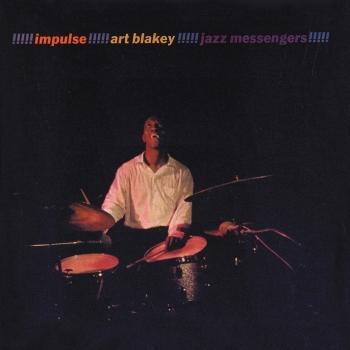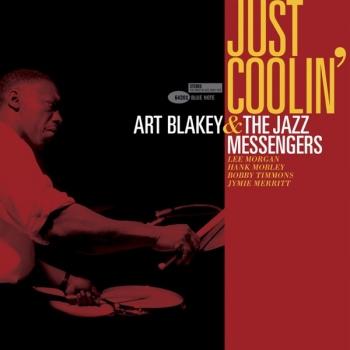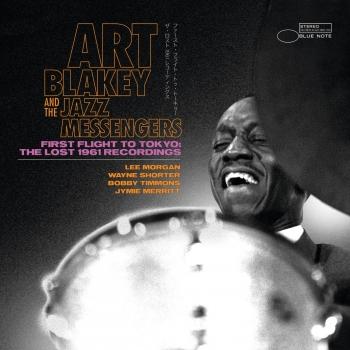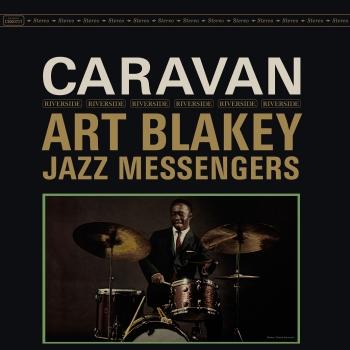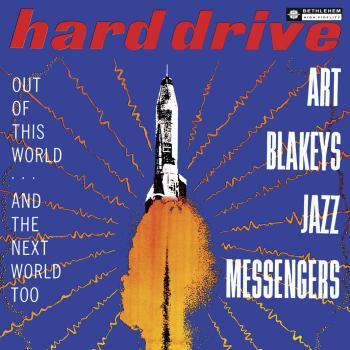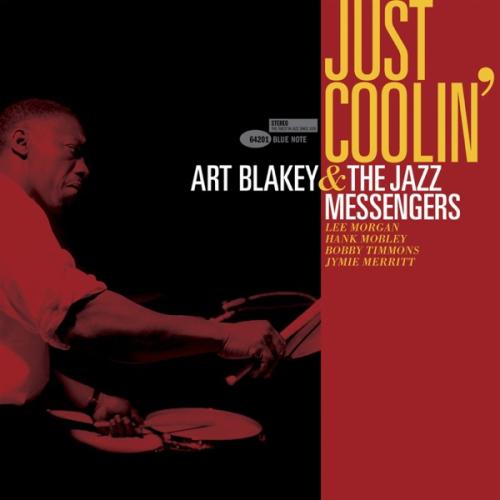
Just Coolin' (Remastered) Art Blakey & The Jazz Messengers
Album Info
Album Veröffentlichung:
2020
HRA-Veröffentlichung:
17.07.2020
Das Album enthält Albumcover
Entschuldigen Sie bitte!
Sehr geehrter HIGHRESAUDIO Besucher,
leider kann das Album zurzeit aufgrund von Länder- und Lizenzbeschränkungen nicht gekauft werden oder uns liegt der offizielle Veröffentlichungstermin für Ihr Land noch nicht vor. Wir aktualisieren unsere Veröffentlichungstermine ein- bis zweimal die Woche. Bitte schauen Sie ab und zu mal wieder rein.
Wir empfehlen Ihnen das Album auf Ihre Merkliste zu setzen.
Wir bedanken uns für Ihr Verständnis und Ihre Geduld.
Ihr, HIGHRESAUDIO
- 1 Hipsippy Blues 06:40
- 2 Close Your Eyes 06:26
- 3 Jimerick 06:22
- 4 Quick Trick 04:43
- 5 M&M 05:59
- 6 Just Coolin' 08:43
Info zu Just Coolin' (Remastered)
Ein wahrer Schatz: Sie denken, Sie kennen alles von Art Blakey? Irrtum - sein Album "Just Coolin'" von 1959 lernen Sie es jetzt kennen.
Eine mitreißende, polyrhythmische Spielweise war das Markenzeichen von Art Blakey. Wer meint, von der Schlagzeug-Legende jede Aufnahme zu kennen, wird jetzt eines Besseren belehrt: im August veröffentlicht Blue Note ein Album, das bislang noch niemand gehört hat.
Wie das sein kann? In seiner Glanzzeit in den 50er und 60er Jahren nahm Blue Note in rapidem Tempo so viele Sessions auf, dass komplette Alben auch mal im Archiv verschwinden konnten. Das hatte nichts mit mangelnder Qualität zu tun, wie man bei "Just Coolin'" hört, einer nie zuvor veröffentlichten Studiosession der Jazz Messengers, die am 8. März 1959 im berühmten Studio von Rudy Van Gelder in Hackensack, New Jersey, aufgenommen wurde.
om ersten Takt an ein klares Statement: griffiges Thema, markanter Rhythmus, starke Dynamik – so klang Musik unter der Leitung des Schlagzeugers Art Blakey. Sie hatte mitreißenden Schwung. Die Melodien waren einfacher und klarer umrissen als noch ein Jahrzehnt zuvor, als der „Bebop“-Stil die Töne und manchmal auch die Auffassungsgabe der Zuhörer mächtig durcheinandergewirbelt hatte. Diese Musik hier wollte sich mitteilen, Hard Bop nannte man sie wegen der härteren Konturen. Sie hatte Blues und Soul, viel archaische, schwarze Musik schwang im Hintergrund mit bei diesem Jazz-Stil, für den Art Blakeys Band die Keimzelle wurde.
Die Session versammelte eine rare, weil kurzlebige Besetzung der Jazz Messengers, mit Tenorsaxophonist Hank Mobley, Trompeter Lee Morgan, Pianist Bobby Timmons und Bassist Jymie Merritt. Das Album besteht nicht nur aus 100% bislang ungehörter Musik, sondern beinhaltet auch zwei bisher unveröffentlichte Kompositionen, darunter Bobby Timmons' bereits jetzt als Appetitmacher veröffentlichte Nummer "Quick Trick".
"Jetzt, im Jahr 2020, ist es großartig, mehr von Blakey, Morgan, Mobley und Timmons in ihrer Blütezeit zu entdecken", schreibt Bob Blumenthal in den Liner Notes für "Just Coolin'". Im August diesen Jahres, 61 Jahre nach Aufnahme des Albums, haben Jazzfans erstmals die Möglichkeit, dies ebenfalls zu tun.
Bobby Timmons, Klavier
Hank Mobley, Tenorsaxofon
Lee Morgan, Trompete
Jymie Merritt, Kontrabass
Art Blakey, Schlagzeug
Produced by Alfred Lion
Digitally remastered
Art Blakey
Born in 1919, Art Blakey began his musical career, as did many jazz musicians, in the church. The foster son of a devout Seventh Day Adventist Family, Art learned the piano as he learned the Bible, mastering both at an early age.
But as Art himself told it so many times, his career on the piano ended at the wrong end of a pistol when the owner of the Democratic Club — the Pittsburgh nightclub where he was gigging — ordered him off the piano and onto the drums.
Art, then in his early teens and a budding pianist, was usurped by an equally young, Erroll Garner who, as it turned out, was as skilled at the piano as Blakey later was at the drums. The upset turned into a blessing for Art, launching a career that spanned six decades and nurtured the careers of countless other jazz musicians.
As a young drummer, Art came under the tutelage of legendary drummer and bandleader Chick Webb, serving as his valet. In 1937, Art returned to Pittsburgh, forming his own band, teaming up with Pianist Mary Lou Williams, under whose name the band performed.
From his Pittsburgh gig, Art made his way through the Jazz world. In 1939, he began a three-year gig touring with Fletcher Henderson. After a year in Boston with a steady gig at the Tic Toc club, he joined the great Billy Eckstine, gigging with the likes of Charlie Parker, Dizzy Gillespie, and Sarah Vaughn.
In 1948, Art told reporters he had visited Africa, where he learned polyrhythmic drumming and was introduced to Islam, taking the name Abdullah Ibn Buhaina. It was in the late ’40s that Art formed his first Jazz Messengers band, a 17-piece big band.
After a brief gig with Buddy DeFranco, in 1954 Art met up with pianist Horace Silver, altoist Lou Donaldson, trumpeter Clifford Brown, and bassist Curly Russell and recorded "live" at Birdland for Blue Note Records. The following year, Art and Horace Silver co-founded the quintet that became the Jazz Messengers. In 1956, Horace Silver left the band to form his own group leaving the name, the Jazz Messengers, to Art Blakey.
Art’s driving rhythms and his incessant two and four beat on the high hat cymbals were readily identifiable from the outset and remained a constant throughout 35 years of Jazz Messengers bands. What changed constantly was a seeming unending supply of talented sidemen, many of whom went on to become band leaders in their own right.
In the early years luminaries like Clifford Brown, Hank Mobley and Jackie McLean rounded out the band. In 1959, tenor saxophonist Benny Golson joined the quintet and — at Art’s behest — began working on the songbook and recruiting what became one of the timeless Messenger bands — tenor saxman Wayne Shorter, trumpeter Lee Morgan, pianist Bobby Timmons and bassist Jymmie Merritt.
The songs produced from ’59 through the early ’60s became trademarks for the Messengers — including Timmon’s Moanin’, Golson’s Along Came Betty and Blues March and Shorter’s Ping Pong.
By this time, the Messengers had become a mainstay on the jazz club circuit and began recording on Blue Note Records. They began touring Europe, with forays into North Africa. In 1960, the Messengers became the first American Jazz band to play in Japan for Japanese audiences. That first Japanese tour was a high point for the band. At the Tokyo airport, the band was greeted by hundreds of fans as Blues March played over their airport intercom and their visit was televised nationally.
In 1961, trombonist Curtis Fuller transformed the Messengers into a proper sextet, giving the band the opportunity to incorporate a big band sound into their hard bop repertoire. Throughout the ’60s, the Messengers remained a mainstay on the jazz scene with jazz greats including Cedar Walton, Chuck Mangione, Keith Jarrett, Reggie Workman, Lucky Thompson and John Hicks. In the jazz drought of the ’70s, the Messengers remained a strong force, with fewer recordings, but no less energy. At a time when many jazz musicians were experimenting with electronics and fusing their music with pop, the Messengers were a mainstay of straight-ahead jazz.
Art’s steadfast belief in jazz music left him well positioned to take advantage of the music’s resurgence in the early ’80s. Art had been working with musicians including trumpeter Valery Ponomarev, tenor Billy Pierce, alto saxman Bobby Watson and pianist James Williams. Trumpeter Wynton Marsalis’ 1980 entrance into the band coincided — and played no small part in — the resurgence of the music in the ’80s.
Throughout the ’80 and until his death in 1990, Art maintained the integrity of the message, incubating the careers of musicians including trumpeters Wallace Rooney and Terence Blanchard, pianists Mulgrew Miller and Donald Brown, bassists Peter Washington and Lonnie Plaxico and many others.
Art died at the age of 71 after a career that spanned six of the best decades of jazz music. The messenger has moved on, but his message lives on in the music of the scores of sidemen whose careers he nurtured, the many other drummers he mentored and countless fans who have been blessed to hear the Messengers’ music. By Yawu Miller, Managing Editor, The Baystate Banner (Boston, MA). Source: www.artblakey.com.
Dieses Album enthält kein Booklet











